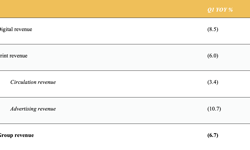| State of online development | |
| Over the course of four issues, Andrea Kirkby will review the state of online development as follows: | |
| Sep/Oct 2005 | National newspapers |
| Nov/Dec 2005 | Consumer magazines |
| Jan/Feb 2006 | Regional newspapers |
| Mar/Apr 2006 | B2B Magazines |
The business to business (B2B) sector has always been streets ahead of other print media in its adoption of the internet, right from the early days. Reed, in particular, seems to have got stuck into electronic transmission of its content very quickly – Richard Foan of ABC Electronic says that ‘the very fact Reed Elsevier’s proud of getting a third of their revenues from online shows they’ve recognised the revolution going on.’
B2B is also well ahead in terms of generating significant revenues from paid-for content. It’s valuable because it is actionable. There is a potential cost, too, to not knowing something. Not knowing who won Celebrity Big Brother might lose you some street cred (or possibly gain you some, depending on who you’re talking to) but not knowing that a major potential customer is inviting tenders for a big contract could cost real money. And, of course, the subscription comes out of a company’s budget and not out of an individual’s pockets, which might help.
So, paid-for content is a significant factor in many B2B publishers’ accounts. Indeed, to some extent, there’s a reversal of the situation in consumer publishing, where all the print media is paid-for, whereas most of the online media is free. In B2B, there are probably more controlled circulation magazines in print, and more paid-for sites on the web. As Jan Pitt of ABC notes, ‘the huge advantage that B2B publishers have is that the web is full of information, but they have the information that counts.’
She believes B2B publishers are using the internet not because they love the technology, but because it makes good business sense. ‘The way I would see it,’ she says, ‘is that, for quite some time, they have been thinking of their readers as audiences, and taking a platform neutral approach - an integrated approach.’ Many have created ‘clusters’ of media, including exhibitions and events as well as print and online media, giving their readers, as well as their advertisers, a choice of approaches, and focusing on the establishment of a loyal user community rather than on any single medium.
Besides, AOP data shows that 82 percent of business decision makers use B2B websites as a source of data and opinion, with, on average, one hour spent using these media each day. When a census shows that they’re using these sites for such purposes as reviewing competitor activity and informing purchasing decisions, as well as for technical reference, you see that many of these individuals see the B2B website as an integral part of their workflow – quite literally, they couldn't do their jobs without it.
Targeted audience
B2B demographics are quite sophisticated. As Jan Pitt points out, ‘in B2B you’re always talking about a targeted audience’ whether the print publication is controlled circulation or paid-for. And it’s quite a small audience - 17,500 copies on average, compared to very much larger figures, often in the hundreds of thousands, for consumer magazines. Even Accountancy Age, which obviously targets a wider market, only has 70,000 readers, which would put it at the low end of the consumer market.
So, what advertisers are interested in – and what circulation managers have to provide – is the definition of that audience, and, in particular, how much those individuals have in their budgets to spend, and what they’re spending it on. A women’s magazine probably doesn’t much care whether any single reader is an accountant or a shop worker – a B2B publication really does care. Of course, such information does have a cost. That’s where electronic distribution has an advantage, in collecting finer information at lower cost. And, as Richard Foan points out, ‘you can do things with online that you can't do with offline.’
The lowest common denominator in B2B publishing is now where magazines put information on the web in an archive, that subscribers can access – buy the magazine, get the website free. Many magazines on the borderline of consumer and B2B – for instance, Investor’s Chronicle and the Economist, both of which contain actionable business information but are often bought by individuals, take this approach. And while Stephen Brooks, publisher of mad.co.uk, believes that you can go a lot further, he admits that ‘it’s a great way of building relationships’ and helps to increase the renewal rate for the print publication.
Online only brands
However, not all publishers have decided to approach web publishing with the same brands as print. Quite a few have decided to aggregate a number of magazines’ content on to a single website, creating a new, online-only, brand. For instance, mad.co.uk targets the whole media industry, delivering news to subscribers of a number of magazines including Marketing Week, Televisual, and In-Store magazine. Haymarket took the same decision with Campaign and Marketing, which together formed a new online brand – Brandrepublic.com.
Naturally, web publishing has its costs. Stephen Brooks, for instance, says, ‘we’re a highly profitable business for Centaur but we have an eight strong editorial team and that’s expensive.’ So, having a wider vertical industry focus than the constituent print publications makes sense – a larger readership to cover your costs, while you can still channel the content to the right individuals by creating personalisation capability or microsites within the main site.
Stephen Brooks says the nature of B2B websites has changed over the past five years. ‘If I was using mad.co.uk as a case study; five years ago, most of the content going on the internet would be the content which was appearing in the magazine – we were simply repurposing content. If you take the picture today, the vast majority of content you see on the site is generated for the site – it’s breaking news happening today. We’re no longer concerned with protecting the print brand.’
The bottom line
That contrasts with what has happened in some other sectors, where print publishers have been leery of the internet’s potential for cannibalising their revenues. Cannibalisation has just never figured as an issue for business publishers – indeed, some have just seen the internet as a brilliant way of reducing costs. Metal Bulletin’s last set of financial results attributed a 1.1 percent increase in gross margin largely due to the migration from print to electronic distribution and a number of other publishers have also benefited from the move. Reed chief executive, Sir Crispin Davis, has mooted the idea that Reed will eventually become an online-only company – though he believes it will still have offline revenues for some time to come. (In science, 75 percent of Reed’s business is already online, and in legal publishing, 70 percent, while its online B2B publishing revenues of USD 300m make it a major online force.)
Enterprise solutions
However, there’s a new wind of change about in business publishing. To see it most clearly, perhaps you need to step outside the ‘print-to-web’ stream of trade magazines and journals and look at less traditional publishers, such as research house Datamonitor. Chief executive Mike Danson says the internet allows you to do a great deal more than merely create an electronic publication. ‘Migration to the internet isn't just about putting a PDF up there instead of sending it to print. You can actually build your information into the client’s desktop, so they can access it within their own operational setup.’
Decision News Media, whose Nutraingedients site was shortlisted for the AOP business website award last year, is also developing corporate solutions. Paul O’Shaughnessy, project director for its corporate news service, says ‘the initiative we’re following at the moment has come about because clients have approached us. Companies want a better way to find and disseminate qualitative content – they want tools enabling them to roll it out within their organisation in the least obtrusive way.’
So that may involve RSS but equally other methods of providing a service, all based on tagging methodologies which are key to a seamless provision of data, and the ability for users to mix feeds.
There are massive advantages to this type of system for the large corporate user – and both Datamonitor and Decision News Media have a blue chip client base. First of all, unlike the weighty paper reports Datamonitor used to (and still does) put out, a searchable internet database never becomes out of date. Data such as market statistics can be updated at any time, and there will always be a link to the most recent story on any subject, so the latest news isn't missed. Besides, bringing links – perhaps from a number of publishers – into a corporate resource means the reinvention of the corporate library or clippings service; users can be focused on to useful resources. When research house IDC reckons only 21% of web searches find the right information, that’s a huge saving of management time.
That may mean that the online product doesn’t look much like a publication any more. Mike Danson says ‘it’s about datasets, content sets’ – leveraging the databases and analysis that Datamonitor produces in a number of different ways.
It also means that ease of access, and particularly speed of access, increases in importance. Tools such as alerts, different search techniques, association, possibly even collaborative filtering, become key to reducing the amount of time users spend looking for information. These aren't bells and whistles – they are basic functional necessities given the depth and complexity of information on some of these sites. Datamonitor, for instance, reckons its new service can reduce what used to be a two or three day research job down to 15 minutes. These services are what Paul O’Shaughnessy calls ‘enterprise solutions’ – and they up the ante considerably for the sector.
Monitoring usage
They also add a rather interesting facility for the big corporate subscriber. With print, and with traditional websites, the large enterprise has no idea whether the subscription is useful or not. But Paul O’Shaughnessy says, with the Decision News Media corporate service, ‘we can tell a company how many people have set up how many alerts, how many searches have been carried out,’ though, he says, they don’t split out what has been searched for or who has searched, to protect privacy.
He believes that, with scientific journals in particular, ‘it’s very much a return on investment model that’s being applied’ – large companies want to know if they are getting value from their subscriptions. And they need data to help them work that out.
These companies are in the forefront of changing technology, and they need to be, because their large clients have extensive IT systems and want their research and news services integrated into them. Those publications addressing smaller companies are probably never going to face such intense demands, but even there, users’ requirements are becoming more exacting.
Stephen Brooks says that ‘personalisation has been a long time coming and, to a certain extent, we are doing it now. Building the content into corporate intranets has been possible for some time – and it’s something we have been actively investigating.’ And individuals expect services such as RSS to be available, so they do not need to access the site in order to see the basic headlines.
But, he says, the problem with the corporate services is that there has to be a compelling reason for the individual to go to the corporate intranet. ‘A magazine comes into your inbox, you see it, you have to do something with it.’ And the problem with RSS is that ‘there’s always a nagging doubt that there’s something you haven't selected, something you haven't heard about.’ So, he believes, the traditional publication website will survive, as the best place to get a helicopter view of the industry. Maybe not the best place to do research, but certainly the best place to get ‘a snapshot of what’s happened today’. RSS and corporate links will have a place as complements to the website, but he doesn’t believe people will come to rely on them exclusively.
Content – the critical factor
And, while accessibility and ease of use are becoming increasingly important, content is still the critical factor. Authoritative content is vital – and that means, without hiring good journalists and analysts, however good your technology, you will not succeed. Stephen Brooks, for instance, believes that the type of website that simply provides stories that are accessible elsewhere, will go out of business. Successful publications need to add context and analysis – something the user cannot get from elsewhere. Breaking news without that analysis is just a commodity.
Paul O’Shaughnessy also believes ‘you need content to be authoritative and to analyse what’s going on. Yes there’s a new product, but what does it mean? Who are the winners, who are the losers? You need to provide all this.’ And that’s primarily what users are accessing these sites for – online bulletin boards, forums, and blogs are rarer on B2B sites than they are in the consumer sector (IT sites are a significant exception here). After all, business users are short of time – do they want information or do they want to chat?
So, users in B2B still accept the traditional roles of reader and editor, which are being broken down on the consumer side. No citizen journalists in trade journalism. And thus, traditional media skills remain the sine qua non for B2B publishers – whether online or off. But make no mistake, the base level of functionality for the B2B website is rising all the time.










